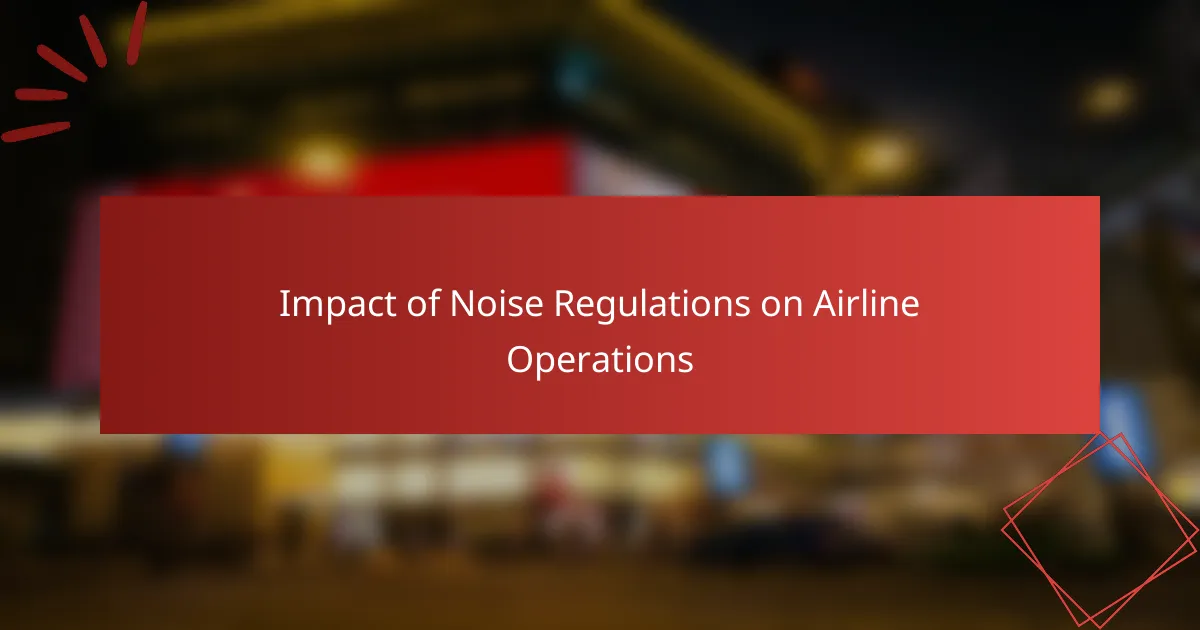Noise regulations play a crucial role in shaping airline operations in the United States by enforcing limits on aircraft noise during critical phases of flight. These regulations are designed to protect communities near airports from excessive noise pollution, prompting airlines to implement strategies such as upgrading aircraft and adopting noise abatement procedures to ensure compliance while maintaining efficiency.
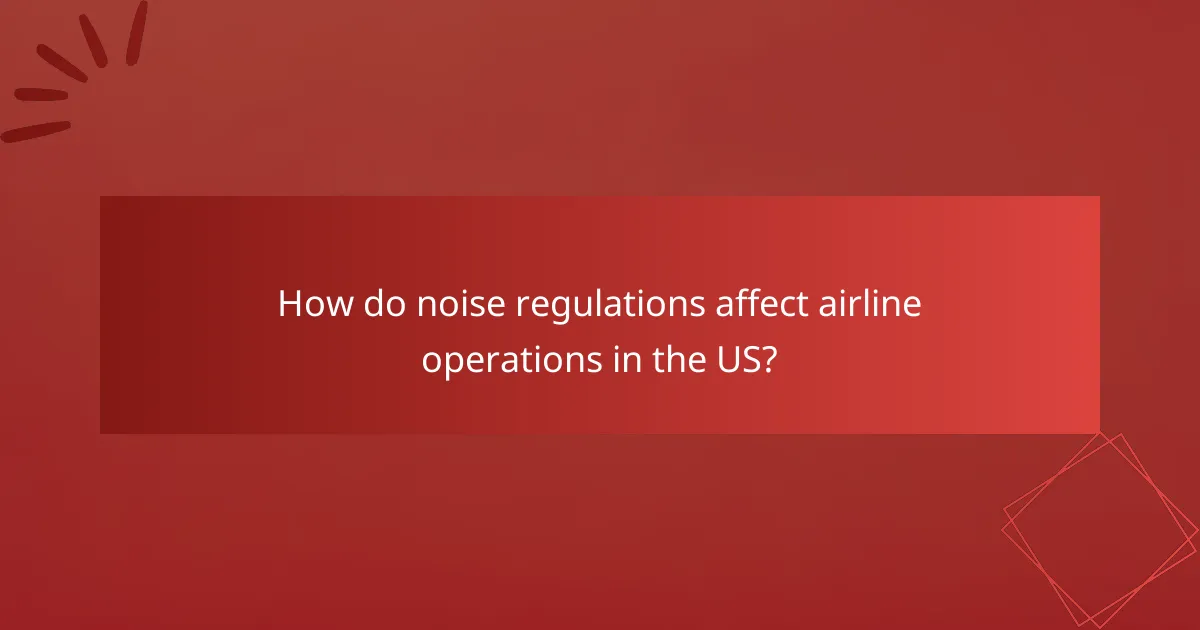
How do noise regulations affect airline operations in the US?
Noise regulations significantly impact airline operations in the US by imposing restrictions on aircraft noise levels during takeoff, landing, and taxiing. These regulations aim to minimize the disturbance to communities near airports, leading airlines to adapt their practices accordingly.
Operational adjustments
Airlines often make operational adjustments to comply with noise regulations, which can include altering flight paths and modifying engine settings. For instance, pilots may be instructed to use quieter ascent and descent profiles to reduce noise during critical phases of flight. These adjustments can lead to increased fuel consumption and longer flight times.
Additionally, airlines may invest in newer, quieter aircraft that meet stricter noise standards. This transition can be costly but is often necessary to maintain access to key airports affected by noise complaints.
Flight scheduling changes
To adhere to noise regulations, airlines may change their flight schedules, particularly during nighttime hours when noise restrictions are more stringent. This can result in reduced flight frequency or the cancellation of late-night and early-morning flights, impacting passenger convenience and airline revenue.
Airlines must carefully analyze demand patterns to optimize their schedules while remaining compliant with noise restrictions. For example, shifting flights to earlier or later times can help mitigate noise issues while still accommodating passenger needs.
Aircraft noise compliance
Compliance with aircraft noise regulations requires airlines to ensure their fleets meet specific noise certification standards set by the Federal Aviation Administration (FAA). This involves regular maintenance and upgrades to aircraft to reduce noise emissions.
Airlines face penalties for non-compliance, which can include fines or restrictions on operations at certain airports. Therefore, maintaining compliance is not only a regulatory requirement but also a critical aspect of operational strategy to avoid disruptions and maintain a positive community relationship.
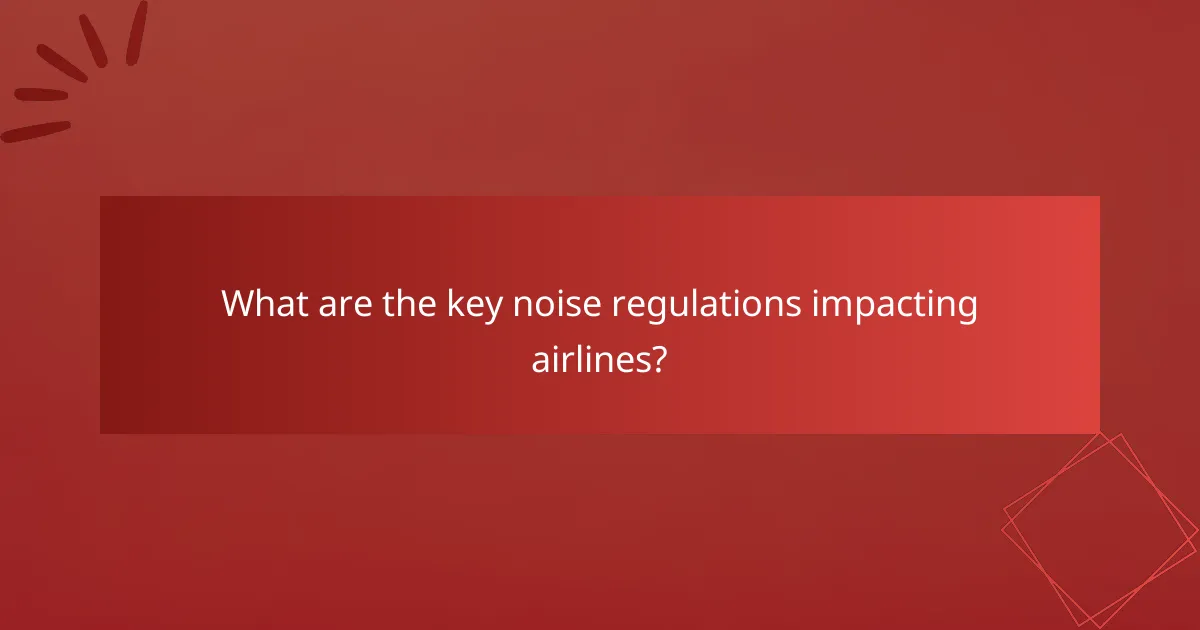
What are the key noise regulations impacting airlines?
Key noise regulations impacting airlines include federal guidelines, international standards, and local ordinances that govern acceptable noise levels during aircraft operations. These regulations aim to minimize noise pollution around airports and ensure compliance with community standards.
FAA regulations
The Federal Aviation Administration (FAA) enforces noise regulations that primarily focus on limiting noise from aircraft during takeoff and landing. These regulations include the establishment of noise compatibility programs that help airports manage noise impacts on surrounding communities.
Airlines must comply with specific noise level thresholds, which are measured in decibels (dB). For example, aircraft must meet Stage 3 noise standards, which require a maximum noise level of around 85 dB during takeoff and landing. Compliance is essential for maintaining operational licenses and avoiding penalties.
ICAO standards
The International Civil Aviation Organization (ICAO) sets global noise standards that member countries, including the United States, are encouraged to adopt. These standards aim to harmonize noise regulations internationally, facilitating smoother operations for airlines across borders.
ICAO’s Annex 16 outlines noise certification requirements for new aircraft, promoting the use of quieter technologies. Airlines operating internationally must ensure their fleets meet these standards to avoid restrictions in various jurisdictions.
Local noise ordinances
Local noise ordinances vary by municipality and can impose stricter noise limits than federal or international regulations. These ordinances typically dictate operational hours, flight paths, and maximum allowable noise levels during specific times, particularly at night.
Airlines must be aware of these local regulations to avoid fines and operational disruptions. For instance, some airports may restrict takeoffs and landings during nighttime hours to reduce noise disturbances in residential areas. Understanding and adhering to local ordinances is crucial for maintaining good community relations and operational efficiency.
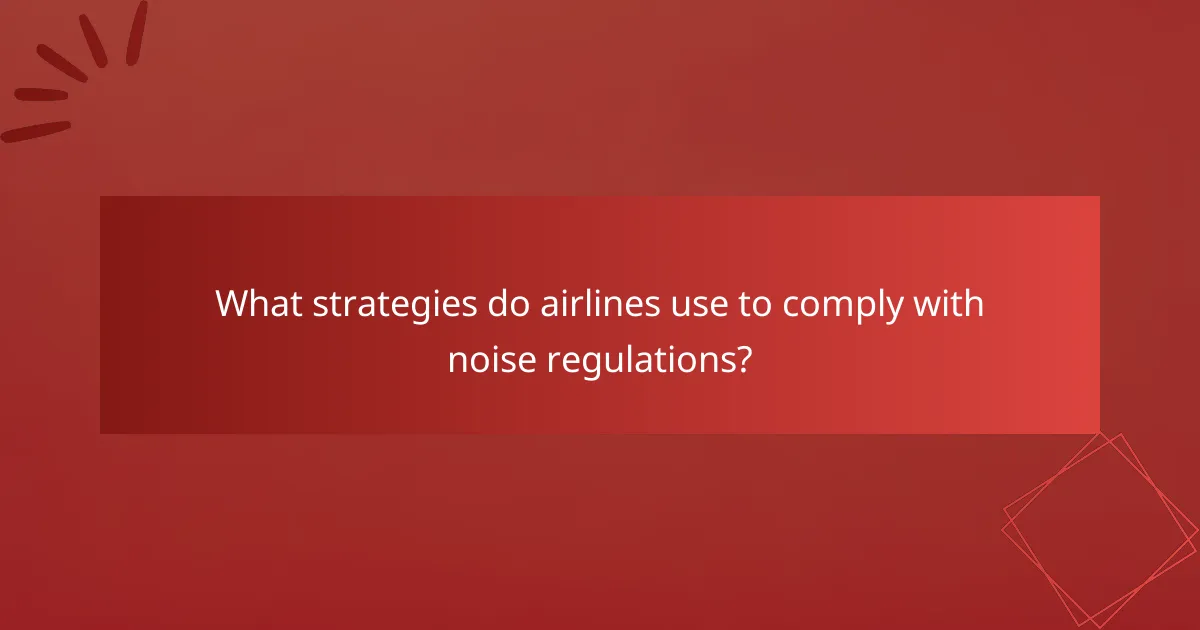
What strategies do airlines use to comply with noise regulations?
Airlines employ various strategies to comply with noise regulations, focusing on aircraft upgrades, noise abatement procedures, and community engagement initiatives. These approaches help minimize noise pollution while maintaining operational efficiency and meeting regulatory requirements.
Aircraft upgrades
Upgrading to quieter aircraft is a primary strategy for airlines to meet noise regulations. Modern aircraft are designed with advanced technologies that significantly reduce noise levels during takeoff and landing. For example, newer models often feature quieter engines and improved aerodynamics, which can lower noise emissions by substantial margins.
Airlines may also consider retrofitting older aircraft with noise-reduction technologies. This can include installing soundproofing materials or modifying engine components to enhance performance while reducing noise output. Such upgrades can be a cost-effective way to extend the operational life of older fleets while complying with stricter noise standards.
Noise abatement procedures
Noise abatement procedures are operational strategies that airlines implement to minimize noise during critical phases of flight. These procedures often include specific flight paths, altitude restrictions, and reduced thrust settings during takeoff and landing. By adhering to these guidelines, airlines can significantly lower noise levels in communities near airports.
Airlines typically work closely with air traffic control to optimize flight routes and timings, ensuring that they avoid densely populated areas whenever possible. Implementing these noise abatement procedures not only helps in regulatory compliance but also fosters better relationships with local communities.
Community engagement initiatives
Engaging with local communities is essential for airlines to address noise concerns effectively. Many airlines establish communication channels to inform residents about noise reduction efforts and gather feedback on their operations. This proactive approach can help mitigate community opposition and foster goodwill.
Airlines may also participate in local forums or committees focused on noise management, allowing them to collaborate with stakeholders, including local governments and residents. By demonstrating a commitment to reducing noise and addressing community concerns, airlines can enhance their public image while ensuring compliance with noise regulations.

How do noise regulations influence airport operations?
Noise regulations significantly impact airport operations by imposing restrictions that airlines must adhere to in order to minimize noise pollution. These regulations can affect various aspects of flight operations, including runway usage, flight paths, and operational hours.
Runway usage restrictions
Runway usage restrictions are often implemented to limit noise exposure in surrounding communities. Airports may designate specific runways for takeoffs and landings during certain hours, which can lead to increased congestion on the remaining runways. Airlines must plan their schedules accordingly to comply with these restrictions, which can affect overall efficiency and flight times.
For example, an airport might restrict the use of a particular runway during nighttime hours to reduce noise complaints. Airlines may need to adjust their flight schedules to accommodate these limitations, potentially resulting in longer travel times or increased operational costs.
Flight path modifications
Flight path modifications are another way noise regulations influence airport operations. Authorities may require airlines to alter their standard flight paths to avoid densely populated areas, which can lead to longer flight routes and increased fuel consumption. These changes are often designed to minimize noise impact on residential neighborhoods.
Airlines must work closely with air traffic control to ensure compliance with these modified paths, which can complicate flight planning. For instance, a flight path that previously took a direct route may now require a detour, adding several minutes to the flight duration.
Operational hours limitations
Operational hours limitations restrict when airlines can conduct flights, particularly during nighttime or early morning hours. Many airports impose curfews to limit noise disturbances during these times, which can lead to reduced flight frequency and scheduling challenges for airlines.
Airlines must carefully consider these limitations when planning their schedules. For example, if an airport restricts operations from 11 PM to 6 AM, airlines may need to adjust their departure and arrival times to avoid penalties, potentially leading to fewer available slots during peak travel times.
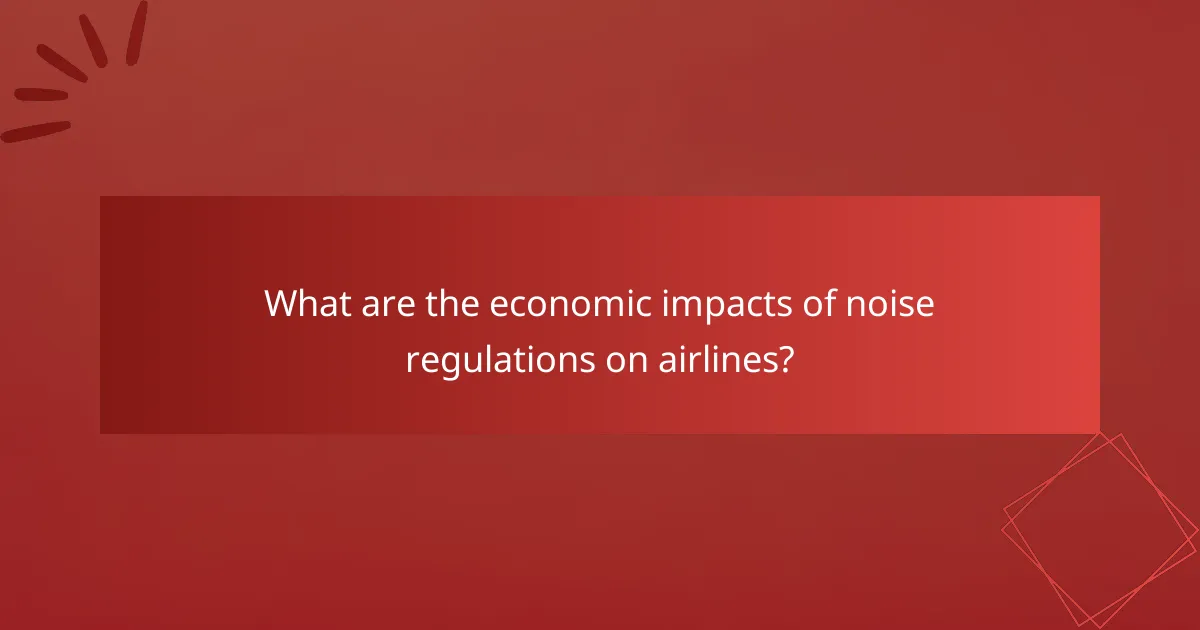
What are the economic impacts of noise regulations on airlines?
Noise regulations significantly affect airlines’ economic performance by increasing operational costs, influencing ticket pricing, and altering market competitiveness. These regulations often require airlines to invest in quieter aircraft and implement specific operational procedures, which can lead to higher expenses and pricing strategies.
Increased operational costs
Compliance with noise regulations typically necessitates substantial investments in quieter aircraft technology and retrofitting existing planes. Airlines may face costs ranging from hundreds of thousands to millions of dollars per aircraft, depending on the required modifications. Additionally, operational changes, such as altered flight paths or adjusted takeoff and landing procedures, can lead to increased fuel consumption and maintenance expenses.
These heightened operational costs can strain airlines’ budgets, especially for smaller carriers that may lack the financial flexibility of larger airlines. As a result, airlines must carefully evaluate their fleet and operational strategies to balance compliance with profitability.
Impact on ticket pricing
To offset increased operational costs from noise regulations, airlines often raise ticket prices. This adjustment can vary based on the airline’s market position and the specific routes affected by regulations. For instance, airlines operating in noise-sensitive areas may increase fares by a few dollars to cover compliance costs, while others may implement more significant price hikes.
Moreover, the impact on ticket pricing can lead to shifts in consumer behavior, as travelers may seek alternatives or adjust their travel plans based on fare changes. This dynamic can further influence demand and pricing strategies across the industry.
Market competitiveness
Noise regulations can alter the competitive landscape among airlines, particularly in regions with strict enforcement. Airlines that invest in quieter technologies may gain a competitive edge, attracting environmentally conscious travelers and securing more favorable landing slots at regulated airports. Conversely, carriers that struggle to comply may lose market share to more adaptable competitors.
Additionally, the cost burden of compliance can lead to consolidation in the industry, as smaller airlines may be unable to sustain the financial pressures. This consolidation can reduce competition, potentially resulting in higher fares and fewer choices for consumers in the long run.

What are the challenges airlines face with noise regulations?
Airlines encounter several challenges due to noise regulations, primarily related to compliance costs and technological limitations. These regulations can lead to increased operational expenses and restrict flight operations, impacting overall efficiency and profitability.
Compliance costs
Compliance with noise regulations often requires significant financial investment from airlines. These costs can include upgrading aircraft to quieter models, implementing noise abatement procedures, and conducting regular noise assessments. For instance, retrofitting older aircraft to meet stringent noise standards can run into millions of dollars.
Additionally, airlines may face penalties for non-compliance, which can further inflate operational costs. Budgeting for these expenses is crucial, as they can account for a substantial portion of an airline’s operational budget, particularly in regions with strict noise regulations.
Technological limitations
Technological advancements in aircraft design have improved noise reduction, but limitations still exist. Many older aircraft models are unable to meet current noise standards without extensive modifications, which may not be economically viable. This creates a challenge for airlines operating mixed fleets.
Moreover, while newer technologies like quieter engines and advanced aerodynamics are being developed, their implementation can be slow due to regulatory approvals and the high costs associated with research and development. Airlines must balance the need for compliance with the pace of technological innovation to remain competitive.
